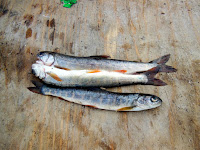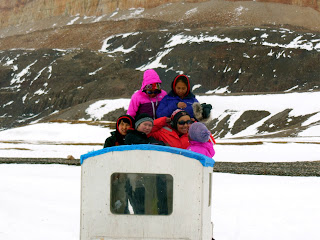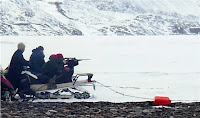 |
| A toy soldier greets me in the morning. |
 |
| Naphtha tank for Coleman stove. |
Reveille was at 8am but
I woke up thirty minutes early to get dressed and ready. When you're a leader in the military, you
need to be awake, alert, and ready at least 30 minutes before your subordinates
wake up. It was Saturday, May 30th, and
the weather was still cloudy. Once all
the cadets were up & about, we immediately went to work on preparing
breakfast.
 |
| Camp site. |
The breakfast MREs were brought outside in several boxes
and placed in a line. (The cadets had
separated everything several weeks before the FTX). Everyone was allowed: a warm meal, side dish
or dessert, bread, crackers, powdered juice, and a spoon. The warm meal packages were placed in pots
with boiling water. The male &
female cadet tents received their own Coleman stoves, enabling them to cook
their own meals. My meals would be
cooked in the male cadet tent. The
breakfast menu varied from person-to-person.
We brought a variety of breakfast, lunch, and dinner meals. All I remember is that my breakfast consisted
of hash browns and bacon.
 |
| Seals in the distance. |
 |
| Ranger Andy. |
Two seals were spotted out on the ice directly across
from the camp. Unfortunately, they were
out of shooting range. A hunting team
was quickly assembled. The team
consisted of Ranger Andy, myself, and several cadets. We tied one of the qamutiks to the back of a
skidoo and set off towards the unsuspecting seals. I gave a senior cadet staying behind a
walkie-talkie so that we could communicate.
I rode in the qamutik with the cadets, filming the experience with my
camera. One of the cadets held a long
stick with a seal hook attached to the end. In Inuktitut, the hunting tool is called a niksik. When Ranger Andy was in range, he stopped the skidoo, turned off the
engine, and aimed his rifle. You can't drive
too close or else the skidoo's engine will scare off the seals. A brief moment of silence followed.
The ranger fired.
Both seals disappeared into a seal hole.
 |
| Seal hole. |
Ranger Andy quickly started the skidoo and drove up to
the seal hole. We all thought he missed
but he actually hit a seal. There was
some blood on the ice, leading us to believe that the bullet had grazed one of
the seals. The unfortunate news was
relayed to the cadets at the camp site.
Thinking that the injured seal would surface again, three cadets
volunteered to the stay behind. I didn't
really mind because they were experienced seal hunters and they were not far
from the camp site. I gave them my
walkie-talkie in case of emergencies.
We returned to the camp site and prepared for the first
morning activity. All the cadets wanted
to go seal hunting. I didn't
object. I would be staying behind to
guard the camp from any visiting polar bears.
(I hold a valid Canadian non-restricted & restricted firearms
license). Ranger Andy gave me a brief
review lesson on how to operate the .22 rifle.
While that was happening, the senior cadets prepared my skidoo for the
hunt. They duct taped pieces of
cardboard over the headlights so that the seals could not see them from a
distance. They also removed one side
panel and placed it in a qamutik they would be pulling. Inuit hunters regularly do this to prevent
skidoo engines from overheating.
 |
| My skidoo after the first seal hunt. The engine needed to be cooled. |
The large and excited seal hunting party left the camp
with two skidoos and two qamutiks. They
picked up the three cadets who were still out on the ice because the wounded
seal had not surfaced. I passed the time
patrolling the camp, taking pictures of the surrounding landscape, and listening
for any radio calls. In the distance I
heard gunshots. The hunting party came
back 90 minutes later without any seals.
Several seals were spotted but they had evaded capture.
Ranger Andy sighted his rifle by taking several practice
shots at an empty naptha can. (He was
pointing the rifle in a safe direction).
He was convinced that the scope needed adjustment. I wore my own earplugs while the unlucky ones
covered their ears with their hands. It
was lunch time when Ranger Andy was finished.
 |
| Cadets choosing their lunches. |
Lunch followed the same routine as breakfast. The cadets lined up to grab their rations and
then returned to their respective tents to cook the warm meals. Clear white snow was collected and melted
into fresh water. We always had one pot
for clean drinking water.
 |
| Small arctic char. |
After lunch I split the cadets into two groups. One group would continue seal hunting while
the other group would go ice fishing behind the camping area. Then the groups would switch activities after
an hour. This arrangement worked out
quite well except no seals were caught again.
Luck was not with us this weekend.
However, the cadets did have better luck catching small arctic char in
the frozen lake.
 |
| 3045 Army group photo. |
The highlight of the day was the bonfire. Wood is very scarce on Baffin Island because
there are no trees. The wood that you do
find in Nunavut mostly comes from leftover sealift boxes & crates. Of course, timber is regularly imported (by
air & sea) into Nunavut for housing, building qamutiks, and
infrastructure. Our firewood came from
leftover sealift boxes & crates. Lt.
May had brought the firewood to the camping site a few days earlier.
 |
| Breaking pieces of firewood. |
We assembled at the fire pit at 8pm. We brought roasting sticks, marshmallows,
hotdogs, bread, condiments, and juice boxes.
We got the fire going by using fire-starter sticks I bought at the local
Co-op, and spare naphtha fuel. It was a
challenge to break the large pieces of wood because we neglected to bring axes
on the FTX. Thankfully, I had my machete
to make the task a little easier.
 |
| Roasting Marshmallows Salute. |
The marshmallows & hot dogs were brought out once the
fire reached a good size. Everyone
surrounded the bonfire and pointed their roasting sticks into the hot
flames. Personally, I like my
marshmallows & hot dogs lightly roasted but there were some cadets who
liked them fully cooked. I passed my
camera around the fire, prompting the cadets to take plenty of pictures of the
event. Parents are always asking what
their kids do on cadet FTXs and photos are an excellent way of answering those
questions. As the fire continued to burn,
I knew there would be plenty of pictures to edit and post on the cadet corps's
Facebook page.
 |
| Back at camp. |
The bonfire was extinguished with piles of white snow at
9pm. We headed back to the camp site
after sweeping the area of garbage.
Lights out was at 11pm.
Morning reveille
was once again at 8am but I woke up much earlier. I immediately rolled up my sleeping bag &
air mattress, and packed all my belongings.
The activities planned for Sunday, May 31 were: breakfast, camp
teardown, and driving back to Arctic Bay.
 |
| Camp teardown. |
Tearing down the camp began almost immediately after
breakfast. All cadets were instructed to
clean out their tents by: collecting all the garbage, rolling up their sleeping
bags & air mattresses, packing all their kit bags, and moving everything
outside, including the cardboard floors & ground sheets. The tents could then be disassembled and
packed onto the qamutiks. Everything was
carefully packed into the qamutiks so that nothing would get broken. The cadets did one last garbage sweep of the
entire bivouac site before I deemed the area to be clean. All that was left were the many heavy rocks
we used to hold down the tent ropes. The
last and most difficult job was cleaning out the washrooms. I won't go into details; I'll just say that
the task was successfully completed.
It was just after 11am when I had the cadets assemble for
a quick debriefing. I congratulated them
for making the FTX a success, for tearing down the camp in an orderly fashion,
and for keeping their heads held high even though they didn't catch any seals.
 |
| Me sitting on my skidoo. |
Since we only had three skidoos, one of them had to pull
two qamutiks while the other two only pulled one each. We met up with Lt. May halfway to Arctic Bay
and had him pull one of the extra qamutiks.
We arrived in town after 1pm. The
cadets were dismissed for the remainder of the day but were instructed to wash
their sleeping bag liners. All the
issued kit would be collected and placed back in storage on Wednesday, June
3rd.
Overall, Operation Spring Fix 15 was a success. I didn't have any disciplinary problems and
came back alive. I had survived my first
FTX as the only officer out-in-the-field.
"See, it wasn't that hard," commented Lt. May.
End of Operation
Spring Fix 15 mini-series.











No comments:
Post a Comment